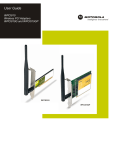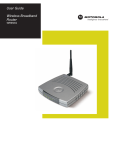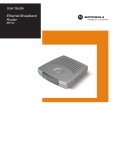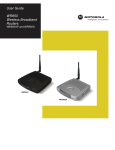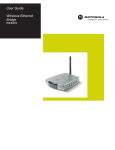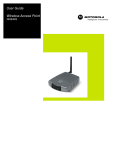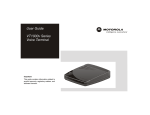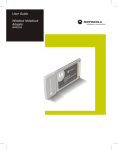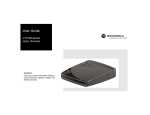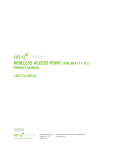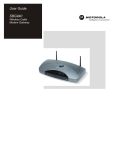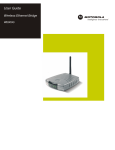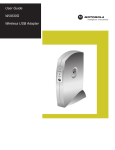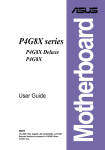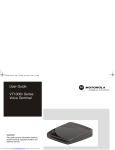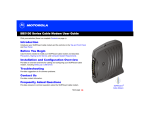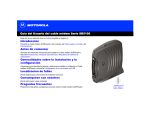Download Motorola WPCI810GP User guide
Transcript
User Guide
Wireless PCI Adapter
WPCI810G
WARNING: TO PREVENT FIRE OR SHOCK HAZARD, DO NOT EXPOSE THIS PRODUCT TO RAIN OR MOISTURE. THE UNIT MUST NOT BE
EXPOSED TO DRIPPING OR SPLASHING. DO NOT PLACE OBJECTS FILLED WITH LIQUIDS, SUCH AS VASES, ON THE UNIT.
CAUTION: TO ENSURE REGULATORY COMPLIANCE, USE ONLY THE PROVIDED POWER AND INTERFACE CABLES.
CAUTION: DO NOT OPEN THE UNIT. DO NOT PERFORM ANY SERVICING OTHER THAN THAT CONTAINED IN THE INSTALLATION AND
TROUBLESHOOTING INSTRUCTIONS. REFER ALL SERVICING TO QUALIFIED SERVICE PERSONNEL.
This device must be installed and used in strict accordance with the manufacturer’s instructions as described in the user documentation that comes with the
product.
Postpone router installation until there is no risk of thunderstorm or lightning activity in the area.
Do not overload outlets or extension cords, as this can result in a risk of fire or electric shock. Overloaded AC outlets, extension cords, frayed power cords,
damaged or cracked wire insulation, and broken plugs are dangerous. They may result in a shock or fire hazard.
Route power supply cords so that they are not likely to be walked on or pinched by items placed upon or against them. Pay particular attention to cords where
they are attached to plugs and convenience receptacles, and examine the point where they exit from the product.
Place this equipment in a location that is close enough to an electrical outlet to accommodate the length of the power cord.
Place this equipment on a stable surface.
When using this device, basic safety precautions should always be followed to reduce the risk of fire, electric shock and injury to persons, including the
following:
•
Read all of the instructions {listed here and/or in the user manual} before you operate this equipment. Give particular attention to all safety precautions.
Retain the instructions for future reference.
•
Comply with all warning and caution statements in the instructions. Observe all warning and caution symbols that are affixed to this equipment.
•
Comply with all instructions that accompany this equipment.
•
Avoid using this product during an electrical storm. There may be a risk of electric shock from lightning. For added protection for this product during a
lightning storm, or when it is left unattended and unused for long periods of time, unplug it from the wall outlet, and disconnect the cable system. This will
prevent damage to the product due to lightning and power surges.
•
Operate this product only from the type of power source indicated on the product’s marking label. If you are not sure of the type of power supplied to your
home, consult your dealer or local power company.
•
Upon completion of any service or repairs to this product, ask the service technician to perform safety checks to determine that the product is in safe
operating condition.
It is recommended that the customer install an AC surge protector in the AC outlet to which this device is connected. This is to avoid damaging the equipment by
local lightning strikes and other electrical surges.
Different types of cord sets may be used for connections to the main supply circuit. Use only a main line cord that complies with all applicable product safety
requirements of the country of use.
Installation of this product must be in accordance with national wiring codes.
Place unit to allow for easy access when disconnecting the power cord/adapter of the device from the AC wall outlet.
Wipe the unit with a clean, dry cloth. Never use cleaning fluid or similar chemicals. Do not spray cleaners directly on the unit or use forced air to remove dust.
This product was qualified under test conditions that included the use of the supplied cables between system components. To be in compliance with regulations,
the user must use these cables and install them properly. Connect the unit to a grounding type AC wall outlet using the power adapter supplied with the unit.
Do not cover the device, or block the airflow to the device with any other objects. Keep the device away from excessive heat and humidity and keep the device
free from vibration and dust.
Installation must at all times conform to local regulations.
FCC Compliance Class B Digital Device
This equipment has been tested and found to comply with the limits for a Class B digital device, pursuant to Part 15 of the FCC Rules. These limits are designed
to provide reasonable protection against harmful interference in a residential environment. This equipment generates, uses, and can radiate radio frequency
energy and, if not installed and used in accordance with the instructions, may cause harmful interference to radio communications. However, there is no
guarantee that interference will not occur in a particular installation. If this equipment does cause harmful interference to radio or television reception, which can
be determined by turning the equipment off and on, the user is encouraged to try to correct the interference by one of the following measures:
•
Reorient or relocate the receiving antenna.
•
Increase the separation between the equipment and receiver.
•
Connect the equipment into an outlet on a circuit different from that to which the receiver is connected.
•
Consult the dealer or an experienced radio/TV technician for help.
CAUTION: Changes or modifications not expressly approved by Motorola for compliance could void the user’s authority to operate the equipment.
Canadian Compliance
This Class B digital apparatus meets all requirements of the Canadian Interference Causing Equipment Regulations. Cet appareil numérique de la classe B
respects toutes les exigences du Règlement sur le matériel brouilleur du Canada.
FCC Declaration of Conformity
Motorola, Inc., Broadband Communications Sector, 101 Tournament Drive, Horsham, PA 19044, 1-215-323-1000, declares under sole responsibility that the
WR850G, WE800G, WA840G, WN825G, WPCI810G, and BR700 comply with 47 CFR Parts 2 and 15 of the FCC Rules as a Class B digital device. This
device complies with Part 15 of FCC Rules. Operation of the device is subject to the following two conditions: (1) This device may not cause harmful
interference, and (2) this device must accept any interference that may cause undesired operation.
Wireless LAN Information
The WR850G, WE800G, WA840G, WN825G, and WPCI810G Wireless LAN products are wireless network products that uses Direct Sequence Spread
Spectrum (DSSS) radio technology. This product is designed to be inter-operable with any other wireless DSSS type product that complies with:
•
The IEEE 802.11 Standard on Wireless LANs (Revision B), as defined and approved by the Institute of Electrical Electronics Engineers.
•
The Wireless Fidelity (WiFi) certification as defined by the Wireless Ethernet Compatibility Alliance (WECA).
Wireless LAN and your Health
The WR850G, WE800G, WA840G, WN825G, and WPCI810G, like other radio devices, emits radio frequency electromagnetic energy, but operates within the
guidelines found in radio frequency safety standards and recommendations.
Restrictions on Use of Wireless Devices
In some situations or environments, the use of wireless devices may be restricted by the proprietor of the building or responsible representatives of the
organization. For example, these situations may include:
•
Using wireless equipment on board an airplane.
•
Using wireless equipment in any environment where the risk of interference to other devices or services is perceived or identified as harmful.
If you are uncertain of the applicable policy for the use of wireless equipment in a specific organization or environment (such as airports), you are encouraged to
ask for authorization to use the device prior to turning on the equipment.
The manufacturer is not responsible for any radio or television interference caused by unauthorized modification of the devices included with this product, or the
substitution or attachment of connecting cables and equipment other than specified by the manufacturer. Correction of interference caused by such unauthorized
modification, substitution, or attachment is the responsibility of the user.
The manufacturer and its authorized resellers or distributors are not liable for any damage or violation of government regulations that may arise from failing to
comply with these guidelines.
FCC Certification
The WR850G, WE800G, WA840G, WN825G, and WPCI810G contains a radio transmitter and accordingly has
been certified as compliant with 47 CFR Part 15 of the FCC Rules for intentional radiators. Products that contain a
radio transmitter are labeled with FCC ID and the FCC logo.
Caution: Exposure to Radio Frequency Radiation.
To comply with the FCC RF exposure compliance requirements, the separation distance between the antenna and any person’s body (including hands, wrists,
feet and ankles) must be at least 20 cm (8 inches).
Canada - Industry Canada (IC)
The wireless radio of this device complies with RSS 210 and RSS 102 of Industry Canada.
This Class B digital device complies with Canadian ICES-003 (NMB-003).
Cet appareil numérique de la classe B respects toutes les exigences du Règlement sur le matériel brouilleur du Canada
Copyright © 2003 by Motorola, Inc.
All rights reserved. No part of this publication may be reproduced in any form or by any means or used to make any derivative work (such as
translation, transformation or adaptation) without written permission from Motorola, Inc.
Motorola reserves the right to revise this publication and to make changes in content from time to time without obligation on the part of Motorola to
provide notification of such revision or change. Motorola provides this guide without warranty of any kind, either implied or expressed, including,
but not limited to, the implied warranties of merchantability and fitness for a particular purpose. Motorola may make improvements or changes in
the product(s) described in this manual at any time.
MOTOROLA and the Stylized M Logo are registered in the US Patent & Trademark Office. Microsoft Windows screen shots are used by
permission of Microsoft Corporation. All other product or service names are the property of their respective owners. © Motorola, Inc. 2003
Contents
Section 1:Overview _______________________ 1-1
Features ................................................................................................................ 1-1
Understanding your User Guide ......................................................................... 1-2
Box Contents ........................................................................................................ 1-2
Simple Home Network Diagram .......................................................................... 1-3
Wireless Connections .......................................................................................... 1-3
PCI Adapter Card Physical Description.............................................................. 1-4
Top and Front of PCI Adapter Card ....................................................................1-4
Adapter Card Label .............................................................................................1-5
Section 2:Installation______________________ 2-1
Device Configuration Setup................................................................................. 2-2
Section 3:Configuration ___________________ 3-1
System Tray Icon Description .............................................................................3-1
Connecting to an Existing Wireless Network..................................................... 3-2
Configuring a New Wireless Network ................................................................. 3-3
WPA Configuration for New Network ..................................................................3-7
Configuring Properties for an Existing Wireless Network.............................. 3-10
WPA Configuration for Existing Network ...........................................................3-13
Preferred Networks – Setting up the Connection Order ................................. 3-16
Move up and Move down buttons .....................................................................3-17
Advanced Selection Rules ................................................................................3-17
Removing a Network From Your Preferred Network List................................ 3-18
Viewing Site Monitor Information...................................................................... 3-20
Viewing Link Status............................................................................................ 3-22
Viewing Network Statistics ................................................................................ 3-23
Activating LEAP.................................................................................................. 3-23
Viewing Adapter Product Information .............................................................. 3-25
Section 4:Troubleshooting _________________ 4-1
Contact Us ..........................................................................................................4-1
Hardware Solutions.............................................................................................. 4-1
My computer is experiencing difficulty connecting to the wireless
network..................................................................................................................4-1
I would like to see if my Internet connection is alive......................................................4-2
Section 5:Glossary _______________________ 5-1
CONTENTS
I
Section 1:Overview
Congratulations on purchasing the Motorola Wireless PCI Adapter
WPCI810G. The WPCI810G complies with the 802.11b and the new
nearly 5-times-faster 802.11g wireless standard. With Wi-Fi®
Protected Access (WPA) supported, your wireless connections are
robust and secure, giving you the confidence to communicate without
fear that the signal could be compromised.
After installing the PCI adapter card, you’ll have the ability to
wirelessly connect to your network to receive and send emails and to
print documents to work or play on your PC without restrictions.
Your adapter incorporates the latest technology into an easy to
install, upgradeable package.
Wireless PCI Adapter WPCI810G
Features
The WPCI810G has the following features:
!
CD-ROM based Installation Wizard to provide easy installation
!
Device Configuration and Status Utility
!
Wireless security using WEP, LEAP, or WPA with AES or TKIP
encryption and 802.1X Authentication
!
Compatibility with both 802.11g and 802.11b network standards
!
Upgradeable firmware to stay current with the latest specifications
SECTION 1, OVERVIEW
1-1
OVERVIEW
SECTION 1
Understanding your User Guide
The User Guide is subdivided into the following sections:
Overview
Provides a general introduction for using your
product, the type of technology used, and
recommended practices for using it.
Installation
Provides instructions for installing the hardware
and setting up the firmware to get your adapter
up and running.
Configuration
and Status
Provides details for using the Configuration and
Status Utility to manage your unit.
Troubleshooting Provides a list of frequently asked questions and
possible solutions.
Glossary
List of terms and acronyms used in this book or
used in the field of wireless networking and
networking in general.
Box Contents
Your box contains the following:
Antenna
WPCI810G
CD-ROM
Motorola WPCI81 0G
Wi reless PCIA dapter
Ge t t in g St a rt e d
1
WPCI81
0G
CD- R
OM
WPCI An
tenna
C heck that your b o
x con
t ai ns
t hesei te ms.
( Us e
r G uide : e
S cti o
n 1)
Q u cki S t ra t
u d
G
i e
2
3
I nser t th eIns a
t l ati o
n A ss
i tant
C D- RO M
( Us e
r G uide : e
S cti o
n 2)
I nst la l th esof twar ef or your uni t
fo
r mt he CD -RO M
( Us e
r G uide : e
S cti o
n 2)
4
I nser t you
r card
i nto the PC
( Us e
r G uide : e
S cti o
n 2)
Quick Start
Guide
1-2
SECTION 1, OVERVIEW
OVERVIEW
SECTION 1
Simple Home Network Diagram
Your Wireless PCI Adapter allows you to access files, printers, and
an Internet connection on your network. A sample Local Area
Network (LAN) is shown below:
In the example above, the Internet communicates with the modem
which communicates with the router. The router acts as the gateway
to your network, sending information to whichever device asks for
information. The PCI adapter card enables your desktop to be part of
the wireless network.
Wireless Connections
Your Wireless PCI Adapter uses a radio transmission technology
defined by the Institute of Electrical and Electronics Engineers (IEEE)
called 802.11 Wireless Fidelity (Wi-Fi). This standard is subdivided
into distinct categories of speed and the frequency spectrum used,
designated by the lower case letter after the standard.
For example, your PCI adapter card can work with both the ‘b’ and ‘g’
specifications. The 802.11b specification transmits data rates up to
11 Mbps while the 802.11g specification transmits data rates up to
54 Mbps. Both standards operate in the 2.4 GHz range. These are
theoretical speeds so your performance may vary.
SECTION 1, OVERVIEW
1-3
OVERVIEW
SECTION 1
PCI Adapter Card Physical Description
Top and Front of PCI Adapter Card
The following illustration shows the top and front view of the
WPCI810G:
HIGH PERFORMANCE DATA RATE UP TO 54 Mbps / 802.11g COMPATIBLE
1
MODEL: WPCI810G
PART NUMBER: 498467-001-00
ANT
S/N: PPPPMMYJJJSSSSSCAABBCCCC
FCC ID: F2NWPCI810G
2
ACT.
Tested to comply
With FCC Standards
For Home Or Office Use
This device is approved as
Motorola Model WPCI810G
MAC: AB CD EF 01 23 45
Made in Taiwan
The WPCI810G has the following features:
1-4
Feature
Description
1
ANT
Connection for the antenna
2
ACT
Indicates the activity of the wireless network
traffic
SECTION 1, OVERVIEW
OVERVIEW
SECTION 1
Adapter Card Label
The following illustration shows the label on the WPCI810G:
HIGH PERFORMANCE DATA RATE UP TO 54 Mbps / 802.11g COMPATIBLE
MODEL: WPCI810G
PART NUMBER: 498467-001-00
S/N: PPPPMMYJJJSSSSSCAABBCCCC
Tested to comply
With FCC Standards
For Home Or Office Use
This device is approved as
Motorola Model WPCI810G
FCC ID: F2NWPCI810G
MAC: AB CD EF 01 23 45
Made in Taiwan
MAC Address
The following describes the features on the WPCI810G label:
Feature
Description
Label
Includes the model number, part number, serial
number, and MAC Address
MAC
Address
Location of the PCI adapter card’s MAC
Address
SECTION 1, OVERVIEW
1-5
Section 2:Installation
To install your wireless adapter card:
1
Insert the supplied CD-ROM into the CD-ROM drive. The
software automatically starts the Installation Wizard program.
2
Follow the prompts to setup your adapter card.
If Windows 98SE prompts you for the original Windows CD-ROM,
insert the CD-ROM, and direct Windows to its proper location (for
example, D:\WIN98).
3
When prompted, power down the PC and then unplug the
electrical connection to install the adapter card.
4
Using the instructions you received with your desktop PC, remove
the cover from your desktop PC.
5
Locate an empty PCI slot in your desktop PC.
6
Using the instructions that came with your desktop PC, install the
adapter card. The following illustration is an example of how to
install the card:
7
Re-attach the cover to your desktop computer.
SECTION 2, INSTALLATION
2-1
INSTALLATION
SECTION 2
8
Attach the antenna by aligning the threads on the antenna with
the threads on the ATN connector and turning the antenna
clockwise until the antenna is attached to the connector.
9
Return power to the PC and complete the installation instructions
supplied on the CD-ROM.
Device Configuration Setup
After installing the adapter card and software, you are now able to
connect to wireless networks. Refer to Section 3: Configuration for
information on how to create detailed connectivity profiles so you can
connect to a wireless network, setup security, and setup modes of
operation.
2-2
SECTION 2, INSTALLATION
Section 3:Configuration
You can use the information in this section to:
!
Discover available wireless networks
!
Setup operation modes
!
Create wireless connectivity profiles
!
Setup security
!
Monitor the wireless network / environment
System Tray Icon Description
The icon in you system tray (the area at the bottom right of your
screen in your Task Bar) allows you to view the status of the network
at a glance, as well as, access the Motorola Wireless Configuration
Utility.
The table below describes the various states of the utility.
Icon
Description
The radio transmitter has been disabled from the utility. To
enable, access the utility’s Wireless Networks tab.
There are no networks available.
The signal strength is Very Low.
The signal strength is Low.
The signal strength is Good.
The signal strength is Very Good.
The signal strength is Excellent. The small bars on either
side of the antenna indicate network activity. The bar on the
left indicates transmit and on the right receive.
SECTION 3, CONFIGURATION
3-1
CONFIGURATION
SECTION 3
Connecting to an Existing Wireless Network
Use the following instructions for connecting to a wireless network
that is already in operation.
To connect to an existing wireless network:
1
Double-click the antenna icon in your System Tray. The Connect
to Wireless Network window is displayed:
The window displays any available wireless networks detected.
3-2
2
Highlight the Available network you want to access.
3
If prompted, enter a Network key. Enter the network key you
used to set up security on your access point.
4
Click Connect.
SECTION 3, CONFIGURATION
CONFIGURATION
SECTION 3
Configuring a New Wireless Network
To configure a new wireless network:
1
Double-click the antenna icon in the system tray. The Connect to
Wireless Network window is displayed:
SECTION 3, CONFIGURATION
3-3
CONFIGURATION
SECTION 3
2
3-4
Click Advanced. The Motorola Wireless Configuration Utility
window is displayed:
SECTION 3, CONFIGURATION
CONFIGURATION
SECTION 3
3
Click Add. The following Wireless Network Properties window is
displayed. If you are running the utility with WPA support, refer to
WPA Security Configuration for New Network section.
4
Enter information for the new wireless network.
Field
Description
Network name (SSID)
Enter a Network Name (SSID) from 1 to
32 alphanumeric characters. This is the
SSID for a particular wireless access
point.
Data encryption
(WEP enabled)
The security setting encrypts your
wireless transmission. Select if the type
of security encryption algorithm used on
this network is WEP64 or WEP128.
Network
Authentication
(Shared mode)
Select if your access point requires
Authentication. The option selected
here must match the Authentication
type used by the AP.
SECTION 3, CONFIGURATION
3-5
CONFIGURATION
SECTION 3
Field
Description
Network key
The security key that applies to data
encryption or the network
authentication. This can be entered in
ASCII or hexadecimal.
Key format
Select the format used in the Network
Key field – ASCII or hexadecimal.
Key length
Determines the strength of the network
key. WEP128, the stronger security
regimen, is recommended.
The options are:
!
!
For WEP64 keys, 5 case sensitive
ASCII characters are allowed or 10
hexadecimal characters (using only
characters 0-9 and A-F).
For WEP128 keys, 13 case
sensitive ASCII characters are
allowed or 26 hexadecimal
characters (using only characters 09 and A-F).
Key index (advanced)
There are four Keys (1, 2, 3, 4) that can
be selected. The key selected must
match the wireless network’s Key index.
The key is provided
for me automatically
This refers to dynamic key generation
provided by a RADIUS server. If your
network is configured with dynamic key
management, then check this box.
Otherwise, leave unchecked.
This is a
Select if the network you are creating is
computer-to-computer a computer-to computer (ad hoc)
(ad hoc) network
network.
5
3-6
After entering the information for your network, click OK. The
Motorola Wireless Configuration Utility window is again displayed
and the new network is listed in the Preferred networks area.
SECTION 3, CONFIGURATION
CONFIGURATION
SECTION 3
WPA Configuration for New Network
The Wireless Network Properties screen, seen below, is available if
you are running WPA support provided by Funk on the supplied
CD-ROM or Windows XP with WPA support installed.
If you do not currently have WPA support installed for:
!
Windows 98SE, ME, 2000: utilize the Funk utility located on the
CD-ROM.
!
Windows XP SP 1: refer to Microsoft’s website and knowledge
base article 815485 or search for “WPA support” on their website.
Enter information for the new wireless network that can use WPA
support.
Field
Description
Network name (SSID)
Enter a Network Name (SSID) of no more
than 32 alphanumeric characters. This
must match the SSID for the network you
are joining.
SECTION 3, CONFIGURATION
3-7
CONFIGURATION
SECTION 3
Field
Description
Network
Authentication
Select if your access point requires
Authentication. The option selected here
must match the Authentication type used by
the AP. The options are:
Open
System
The Open System
Authentication method is
used, meaning the AP you
are trying to associate with
will not verify the
identification your unit.
Shared
The Shared (PSK)
authentication method is
used. You need to share
the same key between
your AP and client.
WPA
Wi-Fi® Protected Access
(WPA) authentication
(802.1X) is used with an
EAP type.
WPA-PSK
WPA authentication
(802.1X) is used with a
pre-shared key.
Motorola recommends using WPA-PSK
because it provides the strongest security
algorithm.
Data encryption
Select the type of security encryption
algorithm used on this network. The
security setting encrypts your wireless
transmission.
WEP
Wired Equivalent Privacy
TKIP
Temporal Key Integrity
Protocol - changes the
temporal key often (provides
1 Key)
AES
Advanced Encryption
Standard (provides 1 Key)
Motorola recommends using AES because
it provides the strongest security algorithm.
3-8
SECTION 3, CONFIGURATION
CONFIGURATION
SECTION 3
Field
Description
Network key/
Confirm network key
The security key that applies to Data
encryption and Network authentication.
Identify the Key used by the network, copy
it and enter it here. Enter the Key again in
Confirm Network key. This option is
unnecessary for WPA.
Key index (advanced)
There are four Keys (1, 2, 3, 4) that can be
selected. The Key selected must match the
network’s Key index.
The key is provided
for me automatically
This refers to dynamic key generation
provided by a RADIUS server. If your
network is configured with dynamic key
management, then check this box.
Otherwise, leave unchecked.
This is a
Select if the network you are creating is a
computer-to-computer computer-to computer (ad hoc) network.
(ad hoc) network
After entering the information for this network, click OK. The Motorola
Wireless Configuration Utility window is again displayed and the new
network is listed in the Preferred networks area.
SECTION 3, CONFIGURATION
3-9
CONFIGURATION
SECTION 3
Configuring Properties for an Existing Wireless Network
To configure network properties for an existing wireless network:
3-10
1
Double-click the antenna icon in the system tray. The Connect to
Wireless Network window is displayed:
2
Click Advanced.
SECTION 3, CONFIGURATION
CONFIGURATION
SECTION 3
3
The Motorola Wireless Configuration Utility window displays:
4
In the Available networks list or the Preferred networks list,
highlight the network you want to configure. In the Available
networks area, click Configure or in the Preferred networks area,
click Properties.
SECTION 3, CONFIGURATION
3-11
CONFIGURATION
SECTION 3
5
The following Wireless Network Properties window is displayed. If
you are running with WPA support, refer to the WPA
Configuration for Existing Network section.
6
If the network you want to configure is open (no encryption, no
authentication), click OK and this network is added to the list of
preferred networks.
7
If the network is not open and requires WEP data encryption,
click Data encryption (WEP enabled).
8
If the network is not open and requires network authentication,
click Network Authentication (Shared mode).
9
Edit the fields that you want to change for the selected wireless
network. For additional information about the fields on this
window, refer to Configuring a New Wireless Network.
10 Click OK.
3-12
SECTION 3, CONFIGURATION
CONFIGURATION
SECTION 3
WPA Configuration for Existing Network
The Wireless Network Properties screen, seen below, is available if
you are running WPA support provided by Funk on the supplied
CD-ROM or Windows XP with WPA support installed.
If you do not currently have WPA support installed for:
!
Windows 98SE, ME, 2000: utilize the Funk utility located on the
CD-ROM.
!
Windows XP SP 1: refer to Microsoft’s website and knowledge
base article 815485 or search for “WPA support” on their website.
Edit the information for the selected wireless network.
Field
Description
Network name (SSID)
Enter a Network Name (SSID) of no more
than 32 alphanumeric characters. This
must match the SSID for the network you
are joining.
SECTION 3, CONFIGURATION
3-13
CONFIGURATION
SECTION 3
Field
Description
Network
Authentication
Select if your access point requires
Authentication. The option selected here
must match the Authentication type used by
the AP. The options are:
Open
System
The Open System
Authentication method is
used, meaning the AP you
are trying to associate with
will not verify the
identification your unit.
Shared
The Shared (PSK)
authentication method is
used. You need to share
the same key between
your AP and client.
WPA
Wi-Fi® Protected Access
(WPA) authentication
(802.1X) is used with an
EAP type.
WPA-PSK
WPA authentication
(802.1X) is used with a
pre-shared key.
Motorola recommends using WPA-PSK
because it provides the strongest security
algorithm.
Data encryption
Select the type of security encryption
algorithm used on this network. The
security setting encrypts your wireless
transmission.
WEP
Wired Equivalent Privacy
TKIP
Temporal Key Integrity
Protocol - changes the
temporal key often (provides
1 Key)
AES
Advanced Encryption
Standard (provides 1 Key)
Motorola recommends using AES because
it provides the strongest security algorithm.
3-14
SECTION 3, CONFIGURATION
CONFIGURATION
SECTION 3
Field
Description
Network key/
Confirm network key
The security key that applies to Data
encryption and Network authentication.
Identify the Key used by the network, copy
it and enter it here. Enter the Key again in
Confirm Network key. This option is
unnecessary for WPA.
Key index (advanced)
There are four Keys (1, 2, 3, 4) that can be
selected. The Key selected must match the
network’s Key index.
The key is provided
for me automatically
This refers to dynamic key generation
provided by a RADIUS server. If your
network is configured with dynamic key
management, then check this box.
Otherwise, leave unchecked.
This is a
Select if the network you are creating is a
computer-to-computer computer-to computer (ad hoc) network.
(ad hoc) network
After finished editing the information for the network, click OK. The
Motorola Wireless Configuration Utility window is again displayed and
the revised network is listed in the Preferred networks area.
SECTION 3, CONFIGURATION
3-15
CONFIGURATION
SECTION 3
Preferred Networks – Setting up the Connection Order
There are two ways you can specify the order that the adapter uses
to try to connect to an available network in your Preferred networks
list:
3-16
!
Using the Move up and Move down buttons
!
Using Advanced selection rules
SECTION 3, CONFIGURATION
CONFIGURATION
SECTION 3
Move up and Move down buttons
Use the Move up and Move down buttons to move a network up and
down in the list of Preferred networks. The adapter tries to connect to
a wireless network in the order you specify in the Preferred networks
list.
To move a network within the list:
1
Highlight the network you want to move.
2
Click either the Move up or Move down button depending on
where you want the selected network to appear in the list.
Advanced Selection Rules
You can select some advanced rules for the adapter to use in
displaying and selecting a network from the list of Preferred
networks.
To select an advanced rule to display and choose a network:
1
On the Motorola Wireless Configuration Utility window, on the
Wireless Networks tab, click Advanced. The Advanced window is
displayed:
2
Choose one of the three ways to display and choose networks
from the Preferred network list. Choosing Access point
networks only or Computer-to-computer networks only limits
the number of networks in your preferred list to only those in an
ad-hoc network.
SECTION 3, CONFIGURATION
3-17
CONFIGURATION
SECTION 3
Removing a Network From Your Preferred Network List
To remove a wireless network from your preferred network list:
1
3-18
Double-click the antenna icon in the system tray. The Connect to
Wireless Network window is displayed:
SECTION 3, CONFIGURATION
CONFIGURATION
SECTION 3
2
Click Advanced. The Motorola Wireless Configuration Utility
window is displayed:
3
In the Preferred networks list, highlight the network you want to
remove.
4
Click Remove. The network is removed from your preferred
network list.
SECTION 3, CONFIGURATION
3-19
CONFIGURATION
SECTION 3
Viewing Site Monitor Information
To view site monitor information:
1
Double-click the antenna icon in the system tray.
2
On the Connect to Wireless Network window, click Advanced.
3
Click the Site Monitor tab.
The Visible Networks list provides information about all of the
detected networks. It lists the Network Name (SSID), Channel,
Signal Strength, and Security.
4
3-20
Highlight a network to get more information about that network in
the Selected Network area of the window. This area provides
information about which wireless transmission standard is used
on the network, a graphic representation of the signal strength,
and the supported transmission rates.
SECTION 3, CONFIGURATION
CONFIGURATION
5
SECTION 3
To obtain more information about a selected network, click
Advanced. The Advanced Site Monitor window is displayed:
This window provides detailed information about the network you
selected.
6
To start a log of network activity, click Start Log. The Save log
file as window is displayed:
7
Select a drive and directory to store the networks.log file.
8
Click Save.
SECTION 3, CONFIGURATION
3-21
CONFIGURATION
SECTION 3
The adapter saves a log of the information listed on the
Advanced Site Monitor window to the networks.log file. The
information is sent to the file approximately every six seconds.
The log is a comma-delimited list that can be imported to a
spreadsheet. You can then view the activity on the network over
a specific time period.
9
Click Stop Log to stop the log information from being sent to the
networks.log file.
10 To freeze the display, click Freeze.
Viewing Link Status
To view link status:
3-22
1
Double-click the antenna icon in the system tray.
2
Highlight the network for which you want to view link status.
3
Click Advanced.
4
Click the Link Status tab. The Link Status tab provides
information about the selected network:
SECTION 3, CONFIGURATION
CONFIGURATION
SECTION 3
Viewing Network Statistics
To view statistics for the network you are connected to:
1
Double-click the antenna icon in the system tray.
2
Highlight the network for which you want to view statistics.
3
Click Advanced. The Motorola Wireless Configuration Utility
window is displayed.
4
Click the Statistics tab. The Statistics tab provides information
about the selected network:
Activating LEAP
Lightweight Extensible Authentication Protocol (LEAP) is an
authentication implementation of 802.1X by Cisco, which provides a
challenge-response authentication mechanism and dynamic WEP
key assignment.
1
Double-click the antenna icon in the system tray.
SECTION 3, CONFIGURATION
3-23
CONFIGURATION
SECTION 3
3-24
2
Highlight the network for which you want to view statistics.
3
Click Advanced. The Motorola Wireless Configuration Utility
window is displayed.
4
Click the LEAP tab.
5
Click Enable LEAP to activate the function.
6
To add a network, click Properties. The LEAP Network
Properties window displays.
SECTION 3, CONFIGURATION
CONFIGURATION
7
SECTION 3
Enter the required information and click OK.
To remove a network:
1
Highlight the network in the Leap Enabled Networks window and
click Remove.
2
Click Apply and then OK to save your changes.
Viewing Adapter Product Information
To view product information for the adapter installed in your PC:
1
Double-click the antenna icon in the system tray.
2
Click Advanced. The Motorola Wireless Configuration Utility
window is displayed.
3
Click the Information tab. The Information tab provides the
firmware version number and hardware and adapter details about
the adapter card:
SECTION 3, CONFIGURATION
3-25
Section 4:Troubleshooting
This section details possible solutions to common problems that
might occur in using the WPCI810G.
Contact Us
If you are unable to locate a solution here, please access our website
at www.motorola.com/broadband/networking for the latest information.
You can also reach us 7 days a week, 24 hours a day at
1-877-466-8646.
Hardware Solutions
My computer is experiencing difficulty connecting to the wireless
network.
!
Ensure that your PC and wireless access point is powered on.
!
Ensure that your wireless PCI adapter is installed correctly and is
active.
!
Ensure that your wireless PCI adapter and access point radio
signal is enabled. Review your access point’s documentation for
further instructions.
!
Ensure that your wireless PCI adapter for your PC and the
wireless access point have the same security settings that will
allow your computer to access the wireless network. Refer to the
Configuration section of the documentation that came with your
access point.
!
Verify that the Access Control List (ACL) is not configured to
block your PC. Refer to the Configuration section of the
documentation that came with your access point.
!
Ensure that your wireless PCI adapter is within range of your
access point or is not behind an obstruction; for example, metal
structures will interfere with the signal, as will 2.4 GHz cordless
phones, and microwaves.
!
Ensure that your access point antenna is connected.
SECTION 4, TROUBLESHOOTING
4-1
TROUBLESHOOTING
SECTION 4
I would like to see if my Internet connection is alive.
For this, you will use the ping command to test the connection.
Before attempting, determine the IP Address of your adapter.
1
2
Open a command prompt by clicking Start and Run.
!
For Windows 98 and ME, in the Open field, type command
and press Enter or OK.
!
For Windows 2000 and XP, type cmd.
!
Or, navigate using your Start button to
Programs>Accessories>Command Prompt.
In the Command window, type ipconfig.
!
You should see an IP address for your adapter, for example:
Ethernet Adapter Local Area Connection:
Connection-specific DNS Suffix. . :
IP Address. . . . . . . . . . . . : 192.168.10.3
Subnet Mask . . . . . . . . . . . : 255.255.255.0
Default Gateway . . . . . . . . . : 192.168.10.1
3
If using a router at home, in the Command window, type ping
followed by the Router’s IP address and press Enter. For
example type: ping 192.168.10.1
The router’s IP address is most likely the default gateway.
4
!
If you receive a reply (the first word will be Reply…), then
your computer is connected to the router. Proceed to Step 4.
!
If you do NOT receive a reply, try from a different computer to
verify that the first PC is not the cause of the problem.
In the Command window, type ping and your ISP’s default
gateway and press Enter.
You can determine your ISP’s default gateway by examining your
modem and or router. Refer to the instructions provided with your
modem/router.
5
4-2
!
If you receive a reply (It might look something like this: Reply
from 216.109.125.72…), then your connection to the Internet
is alive and well.
!
If you do NOT receive a reply, try from a different computer to
verify that the first PC is not the cause of the problem.
If you cannot determine your ISP’s default gateway, ping
www.yahoo.com or another known web location.
SECTION 4, TROUBLESHOOTING
Section 5:Glossary
A
Access Point (AP)
A device that provides wireless LAN connectivity to wireless
clients (stations).
Adapter
A device or card that connects a computer, printer, or other
peripheral device to the network or to some other device. A
wireless adapter connects a computer to the wireless LAN.
Address translation
See NAT.
Ad-Hoc Network
A temporary local area network connecting AP clients together,
usually just for the duration of the communication session. The
clients communicate directly to each other and not through an
established, such as through a router. Also known as: IBSS
(Independent Basic Service Set).
ASCII
The American Standard Code for Information Interchange refers
to alphanumeric data for processing and communication
compatibility among various devices; normally used for
asynchronous transmission.
B
Bandwidth
The transmission capacity of a medium in terms of a range of
frequencies. Greater bandwidth indicates the ability to transmit
more data over a given period of time.
bps
Bits Per Second
Broadband
A communications medium that can transmit a relatively large
amount of data in a given time period.
BSS
Basic Service Set. A configuration of Access Points that
communicate with each other without resorting any infrastructure.
Also known as Ad-Hoc networks. Also see ESS.
SECTION 5, GLOSSARY
5-1
SECTION 5
GLOSSARY
C
Client
In a client/server architecture, a client is a computer that requests
files or services such as file transfer, remote login, or printing
from the server. On an IEEE 802.11b/g wireless LAN, a client is
any host that can communicate with the access point. Also called
a CPE. A wireless client is also called a “station.” Also see server.
Coaxial Cable
A type of cable consisting of a center wire surrounded by
insulation and a grounded shield of braided wire. The shield
minimizes electrical and radio frequency interference. Coaxial
cable has high bandwidth and can support transmission over long
distances.
CPE
Customer Premise Equipment: typically computers, printers, etc,
that are connected to the gateway at the subscriber location. CPE
can be provided by the subscriber or the cable service provider.
Also called a client.
Crossover Cable
A crossover cable is a cable that is used to interconnect two
computers by "crossing over" (reversing) their respective pin
contacts. A crossover cable is sometimes known as a null
modem.
D
Default Gateway
A routing device that forwards traffic not destined to a station
within the local subnet.
DHCP
A Dynamic Host Configuration Protocol server dynamically
assigns IP addresses to client hosts on an IP network. DHCP
eliminates the need to manually assign static IP addresses by
“leasing” an IP address and subnet mask to each client. It
enables the automatic reuse of unused IP addresses.
DMZ
DeMilitarized Zone. This service opens one IP address to the
Internet, usually for online gaming, and acts as a buffer between
the Internet and your network.
DNS
The Domain Name System is the Internet system for converting
domain names (like www.motorola.com) to IP addresses. A DNS
server contains a table matching domain names such as
Internetname.com to IP addresses such as 192.169.9.1. When
5-2
SECTION 5, GLOSSARY
GLOSSARY
SECTION 5
you access the world-wide web, a DNS server translates the URL
displayed on the browser to the destination website IP address.
The DNS lookup table is a distributed Internet database; no one
DNS server lists all domain name to IP address matches.
Domain Name
A unique name, such as motorola.com, that maps to an IP
address. Domain names are typically much easier to remember
than are IP addresses. See DNS.
Download
To copy a file from one computer to another. You can use the
Internet to download files from a server to a computer.
Driver
Software that enables a computer to interact with a network or
other device. For example, there are drivers for printers, monitors,
graphics adapters, modems, Ethernet, USB, HPNA, and many
others.
DSL
Digital Subscriber Line
DSSS
Direct-Sequence Spread Spectrum. DSSS is a transmission
technology used in WLAN transmissions where a data signal at
the sending station is combined with a higher data rate bit
sequence, or chipping code, that divides the user data according
to a spreading ratio. The chipping code is a redundant bit pattern
for each bit that is transmitted, which increases the signal's
resistance to interference. If one or more bits in the pattern are
damaged during transmission, the original data can be recovered
due to the redundancy of the transmission.
Dynamic IP Address
An IP address that is temporarily leased to a host by a DHCP
server. The opposite of Static IP Address.
E
ESS
An Extended Service Set (ESS) is a set of two or more BSSs that
form a single subnetwork. See also BSS.
Ethernet
The most widely used LAN type, also known as IEEE 802.3. The
most common Ethernet networks are 10Base-T, which provide
transmission speeds up to 10 Mbps, usually over unshielded,
twisted-pair wire terminated with RJ-45 connectors. Fast Ethernet
(100Base-T) provides speeds up to 100 Mbps. “Base” means
“baseband technology” and “T” means “twisted pair cable.”’
SECTION 5, GLOSSARY
5-3
SECTION 5
GLOSSARY
Each Ethernet port has a physical address called the MAC
address. Also see MAC address.
Event
A message generated by a device to inform an operator or the
network management system that something has occurred.
F
Firewall
A security software system on the some devices that enforces an
access control policy between the Internet and the LAN for
protection.
Firmware
Code written onto read-only memory (ROM) or programmable
read-only memory (PROM). Once firmware has been written onto
the ROM or PROM, it is retained even when the device is turned
off. Firmware is upgradeable.
FTP
File Transfer Protocol is a standard Internet protocol for
exchanging files between computers. FTP is commonly used to
download programs and other files to a computer from web pages
on Internet servers.
G
Gateway
A device that enables communication between networks using
different protocols. See also router.
GUI
Graphical User Interface
H
Hexadecimal
A base-sixteen numbering system that uses sixteen sequential
numbers (0 to 9 and the letters A to F) as base units before
adding a new position. On computers, hexadecimal is a
convenient way to express binary numbers.
Host
In IP, a host is any computer supporting end-user applications or
services with full two-way network access. Each host has a
unique host number that combined with the network number
forms its IP address.
Host also can mean:
!
5-4
A computer running a web server that serves pages for one or
more web sites belonging to organization(s) or individuals
SECTION 5, GLOSSARY
GLOSSARY
SECTION 5
!
A company that provides this service
!
In IBM environments, a mainframe computer
I
ICMP
Internet Control Message Protocol is a protocol used for error,
problem, and informational messages sent between IP hosts and
gateways. ICMP messages are processed by the IP software and
are not usually apparent to the end-user.
IEEE
The Institute of Electrical and Electronics Engineers, Inc.
(http://www.ieee.org) is an organization that produces standards,
technical papers, and symposiums for the electrical and
electronic industries and is accredited by ANSI. 802.11b and
802.11g are examples of standards they have produced.
Internet
A worldwide collection of interconnected networks using TCP/IP.
IP
Internet Protocol is a set of standards that enable different types
of computers to communicate with one another and exchange
data through the Internet. IP provides the appearance of a single,
seamless communication system and makes the Internet a virtual
network.
IP Address
A unique 32-bit value that identifies each host on a TCP/IP
network. TCP/IP networks route messages based on the
destination IP address.
For a Class C network, the first 24 bits are the network address
and the final 8 bits are the host address; in dotted-decimal format
it appears “network.network.network.host.”
ISDN
Integrated Services Digital Network
ISP
Internet Service Provider
L
LAN
Local Area Network. A local area network provides a full-time,
high-bandwidth connection over a limited area such as a home,
building, or campus. Ethernet is the most widely used LAN
standard.
SECTION 5, GLOSSARY
5-5
SECTION 5
GLOSSARY
M
MAC Address
The Media Access Control address is a unique, 48-bit value
permanently saved in the ROM at the factory to identify each
Ethernet network device. It is expressed as a sequence of 12
hexadecimal digits printed on the unit’s label. You need to
provide the MAC Address to the cable service provider. Also
called an Ethernet address, physical address, hardware address,
or NIC address.
MB
One megabyte; equals 1,024 x 1,024 bytes, 1,024 kilobytes, or
about 8 million bits.
Mbps
Million bits per second (megabits per second). A rate of data
transfer.
MTU
The Maximum Transmission Unit is the largest amount of data
that can be transmitted in one discrete message on a given
physical network. The MTU places an upper bound on the size of
a message that can be transferred by the network in a single
frame. Messages exceeding the MTU must be fragmented before
transmission, and reassembled at the destination.
Multicast
A data transmission sent from one sender to multiple receivers.
See also broadcast and unicast.
N
NAT
Network Address Translation is an Internet standard for a LAN to
use one set of IP addresses for internal traffic and a second set
of IP addresses for external traffic. NAT provides some security
because the IP addresses of LAN computers are invisible on the
Internet.
Network
Two or more computers connected to communicate with each
other. Networks have traditionally been connected using some
kind of wiring.
NIC
A Network Interface Card converts computer data to serial data in
a packet format that it sends over the LAN. A NIC is installed in
an expansion slot or can be built-in. Every Ethernet NIC has a
MAC address permanently saved in its ROM.
5-6
SECTION 5, GLOSSARY
GLOSSARY
SECTION 5
P
Packet
The unit of data that is routed between the sender and
destination on the Internet or other packet-switched network.
PCMCIA
The Personal Computer Memory Card International Association
sets international standards for connecting peripherals to portable
computers. Laptop computers typically have a PCMCIA slot that
can hold one or two PC Cards to provide features such as
Ethernet or wireless connectivity.
PING
A network utility that tests host reachability by sending a small
packet to the host and waiting for a reply. If you PING a computer
IP address and receive a reply, you know the computer is
reachable over the network. It also stands for “Packet Internet
Groper.”
Port Triggering
A mechanism that allows incoming communication with specified
applications.
PPP
Point-to-Point Protocol is used to transport other protocols,
typically for simple links over serial lines. It is most commonly
used to access the Internet with a dial-up modem.
PPPoE
Point-to-Point Protocol over Ethernet. Used by many DSL
Internet Service Providers for broadband connection.
PPTP
Point-to-Point Tunneling Protocol encapsulates other protocols. It
is a new technology to create VPNs developed jointly by several
vendors.
Private IP Address
An IP address assigned to a computer on the LAN by the DHCP
server for a specified lease time. Private IP addresses are
invisible to devices on the Internet. See also Public IP Address.
Protocol
A formal set of rules and conventions for exchanging data.
Different computer types (for example PC, UNIX, or mainframe)
can communicate if they support common protocols.
SECTION 5, GLOSSARY
5-7
SECTION 5
GLOSSARY
Public IP Address
The IP address assigned by the service provider. A public IP
address is visible to devices on the Internet. See also Private IP
Address.
R
RJ-11
The most common type of connector for household or office
phones.
RJ-45
An 8-pin modular connector; the most common connector type for
10Base-T or 100Base-T Ethernet networks.
Roaming
The ability to transfer your wireless session from one AP to
another AP seamlessly.
ROM
Read-Only Memory.
Router
On IP networks, a device connecting at least two networks, which
may or may not be similar. A router is typically located at a
gateway between networks. A router operates on OSI Network
Layer 3. It filters packets based on the IP address, examining the
source and destination IP addresses to determine the best route
on which to forward them.
A router is often included as part of a network switch. A router
can also be implemented as software on a computer.
Routing Table
A table listing available routes that is used by a router to
determine the best route for a packet.
RTS
Request To Send.
S
Server
In a client/server architecture, a dedicated computer that supplies
files or services such as file transfer, remote login, or printing to
clients. Also see client.
Service Provider
A company providing Internet connection services to subscribers.
5-8
SECTION 5, GLOSSARY
GLOSSARY
SECTION 5
SMTP
Simple Mail Transfer Protocol is a standard Internet protocol for
transferring e-mail.
Static IP Address
An IP address that is permanently assigned to a host. Normally, a
static IP address must be assigned manually. The opposite of
Dynamic IP Address.
Station
IEEE 802.11b term for wireless client.
Subscriber
A user who accesses television, data, or other services from a
service provider.
Subnet Mask
A methodology that determines what the router will examine for
the destination of an IP address. A router delivers packets using
the network address.
Switch
On an Ethernet network, a switch filters frames based on the
MAC address, in a manner similar to a bridge. A switch is more
advanced because it can connect more than two segments.
T
TCP
Transmission Control Protocol on OSI transport layer four,
provides reliable transport over the network for data transmitted
using IP (network layer three). It is an end-to-end protocol
defining rules and procedures for data exchange between hosts
on top of connectionless IP. TCP uses a timer to track
outstanding packets, checks error in incoming packets, and
retransmits packets if requested.
TCP/IP
The Transmission Control Protocol/Internet Protocol suite
provides standards and rules for data communication between
networks on the Internet. It is the worldwide Internetworking
standard and the basic communications protocol of the Internet.
Tunnel
To place packets inside other packets to send over a network.
The protocol of the enclosing packet is understood by each
endpoint, or tunnel interface, where the packet enters and exits
the network. VPNs rely on tunneling to create a secure network.
Tunneling requires the following protocol types:
SECTION 5, GLOSSARY
5-9
SECTION 5
GLOSSARY
!
A carrier protocol, such as TCP, used by the network that the
data travels over
!
An encapsulating protocol, such as IPSec, L2F, L2TP, or
PPTP, that is wrapped around the original data
!
A passenger protocol, such as IP, for the original data
U
UDP
User Datagram Protocol. A method used along with the IP to
send data in the form of message units (datagram) between
network devices over a LAN or WAN.
Unicast
A point-to-point data transmission sent from one sender to one
receiver. This the normal way you access websites. See also
multicast.
USB
Universal Serial Bus is a computer interface for add-on devices
such as printers, scanners, mice, modems, or keyboards. USB
supports data transfer rates of 12 Mbps and plug-and-play
installation. You can connect up to 127 devices to a single USB
port.
V
VoIP
Voice over Internet Protocol is a method to exchange voice, fax,
and other information over the Internet. Voice and fax have
traditionally been carried over traditional telephone lines of the
Public Switched Telephone Network (PSTN) using a dedicated
circuit for each line. VoIP enables calls to travel as discrete data
packets on shared lines. VoIP is an important part of the
convergence of computers, telephones, and television into a
single integrated information network.
VPN
A virtual private network is a private network that uses “virtual”
connections (tunnels) routed over a public network (usually the
Internet) to provide a secure and fast connection; usually to users
working remotely at home or in small branch offices. A VPN
connection provides security and performance similar to a
dedicated link (for example, a leased line), but at much lower
cost.
W
WAN
A wide-area network provides a connection over a large
geographic area, such as a country or the whole world. The
5-10
SECTION 5, GLOSSARY
GLOSSARY
SECTION 5
bandwidth depends on need and cost, but is usually much lower
than for a LAN.
WAP
Wireless Access Point or Wireless Access Protocol. See also
Access Point.
WEP
Wired Equivalent Privacy encryption protects the privacy of data
transmitted over a wireless LAN. WEP uses keys to encrypt and
decrypt transmitted data. The access point must authenticate a
client before it can transfer data to another client. WEP is part of
IEEE 802.11b.
Wi-Fi®
Wireless fidelity (pronounced why'-fy) brand name applied to
products supporting IEEE 802.11b/g.
WLAN
Wireless LAN.
WPA
Wi-Fi Protected Access. A security regimen developed by IEEE
for protection of data on a WLAN.
WWW
World Wide Web. An interface to the Internet that you use to
navigate and hyperlink to information.
SECTION 5, GLOSSARY
5-11
Visit our website at:
www.motorola.com/broadband
493961-001
07/03
MGBI



















































